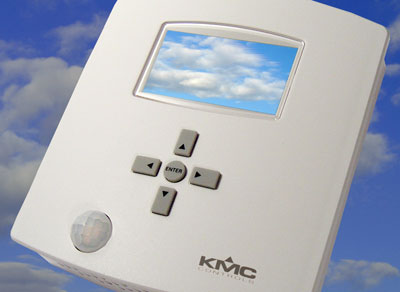Like a Breath of Fresh Air:
Using CO2 Sensors with Demand Control Ventilation

Goldilocks and the Three Ventilation Levels
We take breathing for granted. We breathe in oxygen and breathe out carbon dioxide, and the CO2 levels will increase in an enclosed space that doesn’t have proper ventilation.
Too little ventilation is bad for us. It will make us feel lethargic. Plus, we may be breathing in pollutants (e.g., VOCs, radon, cigarette smoke) that accumulate in inside air and are potentially hazardous to our health (causing increased absenteeism and healthcare costs).
Too much ventilation, on the other hand, is just fine for people but wastes energy in conditioning the extra, unnecessary outside air. HVAC systems in many commercial buildings are designed for a specific number of occupants, but typical occupation levels at any given time are usually lower than these “worst case” design levels. Hence, such building spaces receive more ventilation than necessary and energy is wasted.
Just the right amount of ventilation is the ideal, sustainable balance between protecting indoor air quality (IAQ) and health of occupants versus minimizing energy costs. But how do we achieve that?
 The most effective means of attaining a “Goldilocks” zone for ventilation is by using CO2 sensors and demand control ventilation (DCV) sequences in a Building Automation System. (DCV is also sometimes called demand controlled ventilation.) DCV adjusts the amount of outside air ventilation to keep CO2 levels measured by inside sensors at or below a specified maximum (usually 700 ppm of CO2 above that of outside air, which is typically around 400 ppm). Instead of controlling the ventilation based on preset “worst-case” scenarios, DCV continuously controls ventilation based on real-time actual needs. This produces substantial energy and cost savings...especially for facilities with highly variable occupancy, such as meeting rooms, classrooms, theaters, gyms, retail stores, and hotels. Not only is this an important long-term costs savings for new construction, but retrofits in existing buildings can be expected to reduce ventilation, heating, and cooling loads by 10 to 30% and typically offer paybacks in only a few years.
The most effective means of attaining a “Goldilocks” zone for ventilation is by using CO2 sensors and demand control ventilation (DCV) sequences in a Building Automation System. (DCV is also sometimes called demand controlled ventilation.) DCV adjusts the amount of outside air ventilation to keep CO2 levels measured by inside sensors at or below a specified maximum (usually 700 ppm of CO2 above that of outside air, which is typically around 400 ppm). Instead of controlling the ventilation based on preset “worst-case” scenarios, DCV continuously controls ventilation based on real-time actual needs. This produces substantial energy and cost savings...especially for facilities with highly variable occupancy, such as meeting rooms, classrooms, theaters, gyms, retail stores, and hotels. Not only is this an important long-term costs savings for new construction, but retrofits in existing buildings can be expected to reduce ventilation, heating, and cooling loads by 10 to 30% and typically offer paybacks in only a few years.
CO2 monitoring is becoming increasingly important in both old and new “green” buildings. When a building is seeking LEED certification, implementing the use of CO2 sensors can help obtain an IEQ point for New Construction and Major Renovations (IEQ Credit 1) as well as Existing Buildings: Operations & Maintenance (IEQ Credit 1.2).
CO2 Sensors
Unlike simple, inexpensive thermistors that can reliably measure temperature for many years without any maintenance, CO2 sensors are much more complex. Measuring an invisible gas isn’t easy, and, until recently, CO2 sensors have been quite expensive and have needed periodic, cumbersome recalibration to maintain accuracy.
CO2 sensors are typically mounted in return air ducts or on the walls of the critical zones. Duct sensors (e.g., KMC SAE-1062s) are effective if the sensor is serving large open spaces where concentration levels are largely uniform (e.g., large office spaces or classrooms, lecture halls, and theaters). But they are not good choices for ducts serving multiple spaces where some of the spaces may have much higher occupancy rates at different times than the other spaces. In such cases, the “averaged” levels reading may appear normal even though one zone has extremely high levels. “Critical” zones that may have highly variable levels should also have their own (typically wall-mounted) sensors (e.g., KMC SAE-1011s or SAE-1012s) in addition to or instead of a duct sensor.
Wall-mounted FlexStat integrated controllers and sensors offer a CO2 sensing option in addition to temperature sensing and optional humidity and motion sensing. The BAC-13xxxx series as well as the SAE-10xx models use patented self-calibration techniques designed to be used in applications where concentrations will drop to outside ambient conditions (approximately 400 ppm) at least three times in a 14 day period, typically during unoccupied periods. (These series have been certified to comply with CA Title 24, Section 121(c), as well as sub-paragraph 4.F that specifies accuracy will be maintained within tolerance for a minimum of 5 years without recalibration.)
In zones that may contain people 24/7, however, the inside CO2 levels will not drop to outside levels consistently. For zones with continuous occupancy, the BAC-14xxxx series has a dual-channel sensor. In that sensor, a CO2 channel measures gas concentration, and a reference channel measures the sensor signal intensity. Self-calibrations are performed approximately every 24 hours using the reference channel.
FlexStats provide three levels of sophistication in setup and control of CO2 levels:
- Basic—provides basic DCV, modulating the outside air damper in direct response to the current CO2 level with respect to its setpoint.
- Standard—When the BAC-13xxxx settings are properly configured, this complies with CA Title 24, Section 121(c).
- Advanced—When the settings are properly configured, this complies with ASHRAE Standard 62.1-2010 and follows guidelines by Portland Energy Conservation, Inc. (PECI).
Although BAC-12xxxx FlexStats do not have a built-in CO2 sensor, they still have DCV control sequences available. When DCV is enabled in these models, IN9 is assumed to be connected to an external SAE-10xx CO2 sensor. Thus, a FlexStat can use a remote wall-mounted sensor or duct-mounted CO2 sensor for DCV if desired. BAC-13xxxx/14xxxx FlexStats also have the external sensor option, and if used, the highest of the two readings (internal vs. external) will be used to control DCV.
Additional Resources
KMC Sensors: Sensing Your Needs
KMC Sensors Brochure (SB-057)
Benefits of Controls in Green Buildings
Controls and Green Building Certifications
Why Green Buildings Are Good
Wachovia Bank Building Case Study (with CO2 sensors as part of the retrofit)
Feedback